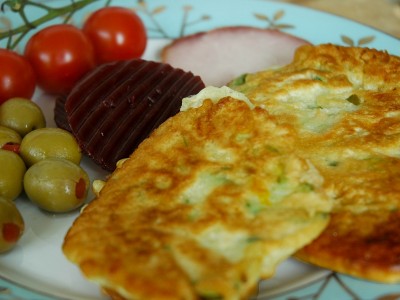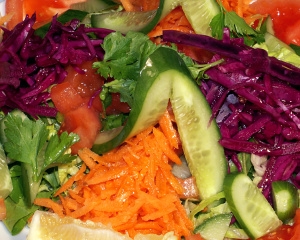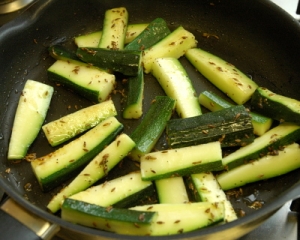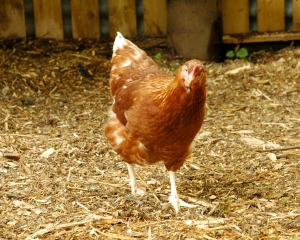John’s Grandma’s marrow flower fritters recipe
I remember eating some of John’s Grandma’s marrow flower fritters at the very start of our relationship and so they always remind me of that exciting trying-new-things-with-a-new-person stage. I’d been thinking about making some with the courgette flowers we’ve had popping up over the last few weeks – when John’s mum arrived with a bag full of them last week.
While I encouraged our niece Mia to play ukelele and take photos of strange things, John and his mum whipped up a batch of fritters for lunch. Here’s the recipe – but unfortunately it’s a bit vague as it’s not been written down in their family for decades (if ever!) <- suggestions for revisions gratefully received!

Ingredients (to make roughly 6 palm-size fritters)
Self Raising Flour about 2oz/50g per egg
The aforementioned egg or eggs
About 6 marrow flowers per egg
Some courgette/zucchini (optional but makes it more of a meal)
Pinch of salt
A little black pepper
A little water
Oil for frying
Method
Tear up the marrow flowers into pieces – size is up to you – anything from confetti size to about half the original petal size. If your plants are already fruiting, you can add a thinly sliced courgette (zucchini) to the mix too.
Mix the flour, egg, salt and water together to achieve the consistency of American pancake/drop scone batter – slightly thicker than usual British pancake batter.
Mix the flowers (and courgette, if you’re using that) into the batter.
Heat up some oil in a frying pan for shallow frying. (John & his mum used less oil when they made them and they stuck & burnt a bit.)
Drop a dollop of the batter-with-flowers into the hot oil and fry until golden brown. Flip over to cook the other side and serve immediately. John & his mum ground some more salt onto the top of the cooked fritters but that made them too salty for me – I’d have much preferred more pepper on top instead.
Big portions vs food waste: a dilemma
While going about our chores, we had lunch in Saltaire on Saturday. We only wanted something light so got sandwiches – but when they arrived, the plates piled high with food – enormous sandwiches, stacks of salad and a generous portion of homemade coleslaw. It’s not often we’re overfaced by food portions but it happened there.
Big portions are obviously good from a being-cheap point of view – if we go back there again, we’ll half the cost by sharing and still probably have enough to eat – and people feel better about paying the (frankly quite expense) prices if they get so much food they can’t eat it. But we both ended up leaving food. Since they were covered in salad dressing and sandwich fillings, the stuff we left probably won’t be composted (if the cafe composts their leftovers at all) so our meal generated food waste that will be sent to landfill.
I like food and I like getting as much for my money as possible but I don’t like stuff going to waste. I might have been happy as a frugal bunny but sad as a waste-reducing greenie.
Has anyone been in a similar situation? Any advice? Where does your preference lie – in perceived value for money or minimal waste?
Read MoreFirst courgettes from the garden
We picked our first courgettes from the garden on Friday night – the first thing we’ve harvested other than herbs and salad from the garden this year.
They’d been ready for picking for a couple of days but we weren’t ready to eat them – but on Friday, we picked some to have in our Mexican-ish dinner. I thought they tested a bit more courgettey than normal and stayed firmer during cooking. John was too busy cramming his mouth with nachos to say much about anything. Here, they’re frying with some cumin seeds and garlic – yum!
These were the first batch of seeds I planted – an early fruiter, although I’ve lost the seed packet so I don’t know exactly what they were. We’ve got five plants of those though and another five of the second batch, which have flowers on but no real fruit yet — there is a strong possibility we’ll be overrun with courgettes later in the summer!
Read MoreMore experiments with wild garlic seed pods
After the pickling success a few weeks ago, I wanted to find other ways to use wild garlic seed pods for the year.
Experiment 1: Mint and wild garlic seed pods pesto
*Everyone* makes pesto from wild garlic leaves so I decided to give it a go with the pods and mint leaves. (After the pickling, I, randomly, went to clean my teeth and noticed that the lingering smell of that chivey garlic on my hands mingled wonderfully with my Sensodyne – and I wondered if that wasn’t a perfect jumping off point for my George’s Marvellous Pesto experiments. As luck would have it, our mint has gone mad this year so I had a lot of leaves to work with.)
The seed pods have a much lower water content than leaves so when blasted together, it was very dry and needed quite a bit of olive oil to make it ooze. Although it’s supposed to be pretty decent oil, the stuff I used added an unpleasant note to the paste – even over the super super strong flavour of the garlic and the mint. All in all, it was a bit overwhelming.
Verdict: Fail.
Read MoreEconomics of having chickens: getting started
After 18 months of waiting, we *finally* got some chickens on Tuesday. This post is the first in what I imagine will be an occasional series about the economics of having chickens.
Despite my tight-fisted frugal heart, having chickens at home isn’t about getting cheap eggs. It’s about getting good eggs from well treated and well fed chickens. It’s about food metres and not food miles. It’s about using up an otherwise hard to make productive bit of ground. It’s about introducing more diversity into our garden and harvesting poop for fertiliser. And it’s about living with some fascinating pseudo-dinosaurs – learning about them, looking after them and laughing at them because they’re such fun, odd things. But while those things are almost priceless, they do have a price.
Back when I first got giddy about the idea of having chickens, I read a great page about the economics of having chickens – breaking it down to the cost per egg over the first year (when there are higher capital costs but potentially high egg production) and in future years (smaller capital cost, slowing egg production etc). It was great – but can I find it now? No. I hate Google sometimes. But I’m going to work out something similar for myself and this post is the first stage of that.
Read More






